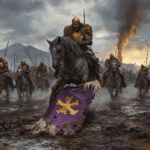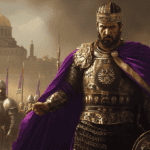
Tsar Simeon the Great, ruler of Bulgaria from 893 to 927, was a figure of immense ambition and cunning. His reign was marked by dramatic conquests, political intrigue, and a relentless pursuit of power that nearly brought the mighty Byzantine Empire to its knees.
The Scholar-Turned-Warrior
Simeon wasn’t initially destined for the throne. Born in 864 or 865, he was the third son of Boris I, the ruler who Christianized Bulgaria. Initially groomed for a religious life, Simeon received an excellent education in Constantinople, earning him the nickname “the half-Greek.” However, fate had other plans for this bookish prince. When his elder brother Vladimir attempted to restore paganism, Boris emerged from retirement, deposed Vladimir, and placed Simeon on the throne. The once-scholarly Simeon quickly proved that he could wield a sword as deftly as a pen, embarking on a series of military campaigns that would earn him the epithet “the Great.”
The Trade War That Sparked an Empire
One of the most fascinating aspects of Simeon’s reign was how a seemingly minor trade dispute escalated into a full-scale war with the Byzantine Empire. In 894, Byzantine Emperor Leo VI, allegedly influenced by his mistress Zoe Zaoutzaina and her father, made a fateful decision: he moved the marketplace for Bulgarian goods from Constantinople to Thessaloniki and imposed heavy taxes on Bulgarian merchants.
This economic slight infuriated Simeon, who saw it as an attack on Bulgarian interests. When his diplomatic protests fell on deaf ears, Simeon did what any reasonable ruler would do – he invaded Byzantine territory. This rash action set off a chain of events that would define Simeon’s reign and reshape the balance of power in the Balkans.

The Magyar Menace and Simeon’s Cunning Counter
The Byzantines, caught off guard by Simeon’s aggression, hatched a devious plan. Unable to face the Bulgarians directly due to their forces being engaged against the Arabs, they reached out to the Magyars, promising to transport them across the Danube to attack Bulgaria from the north.
Simeon, initially unaware of this threat, rushed to meet the Byzantine forces led by Nikephoros Phokas. However, in a twist worthy of a modern political thriller, the Byzantines offered peace while deliberately withholding information about the impending Magyar attack.
Suspicious of Byzantine intentions, Simeon imprisoned their envoy and ordered the Danube route closed off with ropes and chains. This prescient move would prove crucial in the coming conflict.
The Battle That Changed the Map
The Magyar invasion, when it came, was devastating. They ravaged northern Bulgaria, forcing Simeon to retreat to the fortress of Drastar. But Simeon was far from defeated. In a brilliant strategic move, he allied with the Pechenegs, the Magyars’ eastern neighbors.
In 896, Simeon launched a counterattack. The resulting Battle of Southern Buh was a complete victory for the Bulgarians and their Pecheneg allies. The Magyars were so thoroughly routed that they abandoned their lands between the Dnieper and Danube rivers, eventually settling in what would become Hungary.

This victory not only secured Bulgaria’s northern frontier but also demonstrated Simeon’s military acumen. It was a turning point that allowed him to focus his ambitions southward, towards Constantinople.
The Audacious Attempt to Seize Thessaloniki
Simeon’s ambitions knew no bounds. In 904, he saw an opportunity to capture one of the Byzantine Empire’s most important cities – Thessaloniki. The city had just been sacked by Arab pirates, leaving it vulnerable.
In a move that must have sent shockwaves through the Byzantine court, Simeon prepared to seize Thessaloniki and populate it with Slavs. The mere threat of this action forced the Byzantines to make significant territorial concessions in Macedonia and Albania, pushing the Bulgarian border to within 20 kilometers of Thessaloniki.
This bloodless conquest expanded Bulgaria’s territory and influence, bringing Simeon one step closer to his ultimate goal – Constantinople itself.
The Imperial Recognition and the Palace Coup
Simeon’s crowning moment came in 913 when he marched on Constantinople. Taking advantage of political instability following Emperor Leo VI’s death, Simeon’s army reached the capital unopposed. In a dramatic turn of events, Patriarch Nicholas Mystikos, head of the regency council, was forced to negotiate.
The result was beyond Simeon’s greatest expectations. Not only did he secure the payment of tribute arrears and a marriage alliance between his daughter and the young Byzantine Emperor Constantine VII, but he also received official recognition as “Emperor of the Bulgarians” in a ceremony at the Blachernae Palace.
However, Simeon’s triumph was short-lived. In a plot worthy of “Game of Thrones,” Constantine’s mother Zoe returned to power in a palace coup. She promptly disavowed the recognition of Simeon’s imperial title and rejected the planned marriage alliance.

This betrayal would fuel Simeon’s determination to conquer Constantinople for the rest of his life.
The Failed Arab Alliance and the Eagle Omen
Perhaps the most audacious of Simeon’s schemes was his attempt to ally with the Fatimid Caliphate in 924. Recognizing that he needed a navy to capture Constantinople, Simeon sent envoys to Caliph Ubayd Allah al-Mahdi Billah in Cairo.
The caliph agreed to the alliance, but in a stroke of misfortune that could have come straight from a spy novel, the envoys were captured by Byzantine agents in Calabria. The Byzantines quickly offered peace and gifts to the Arabs, scuttling the potential alliance.
Undeterred, Simeon marched on Constantinople once again. In September 924, he met with Emperor Romanos I Lekapenos on the Golden Horn. During their conversation, witnesses reported seeing two eagles meet in the sky above. One flew towards Constantinople, the other towards Thrace – an omen of the continuing conflict between the two empires.
The Serbian Rebellion and Simeon’s Brutal Response
While Simeon was focused on Constantinople, trouble was brewing in his western territories. In Serbia, a ruler named Zaharije, encouraged by the Byzantines, rebelled against Bulgarian authority.
Simeon’s initial response ended in disaster. The army he sent, led by commanders Sigrica and Marmais, was routed, and both leaders were beheaded. This setback forced Simeon to conclude a truce with Byzantium to deal with the Serbian threat.
Simeon’s retaliation was swift and brutal. He sent another army led by Časlav Klonimirović, which successfully deposed Zaharije. Then, in a move of chilling calculation, Simeon invited the Serbian nobility to Bulgaria, ostensibly to recognize a new prince. When they arrived, all were beheaded.
This shocking act of treachery allowed Bulgaria to annex Serbia directly, expanding Simeon’s empire but sowing the seeds of future conflict.

The Legacy of Simeon the Great
Simeon’s reign was a time of both triumph and tragedy for Bulgaria. Under his rule, the Bulgarian Empire reached its territorial apex, stretching from the Black Sea to the Adriatic and from the Aegean to the Carpathians. He transformed his capital, Preslav, into a magnificent city with dozens of churches and monasteries, attempting to rival Constantinople in splendor.
Yet Simeon’s wars against Byzantium, the Hungarians, and the Serbs drained Bulgaria’s resources. His dream of capturing Constantinople and uniting the Bulgarian and Byzantine Empires under his rule remained unfulfilled. When he died of heart failure in 927, he left behind an overextended empire that would soon face significant challenges.
Nevertheless, Simeon’s reign marked the high point of the First Bulgarian Empire. His military successes, diplomatic maneuvering, and cultural achievements earned him the epithet “the Great” and a lasting place in Bulgarian history.
Simeon the Great’s life reads like an epic tale of ambition, betrayal, and near-mythic achievements. From a scholar groomed for the church, he became a warrior-king who almost brought the Byzantine Empire to its knees. His reign was filled with dramatic reversals of fortune, cunning strategies, and brutal acts of reprisal.
While he never achieved his ultimate goal of conquering Constantinople, Simeon transformed Bulgaria into a major power and left an indelible mark on Balkan history. His life serves as a testament to the power of ambition and the unpredictable nature of medieval politics.




